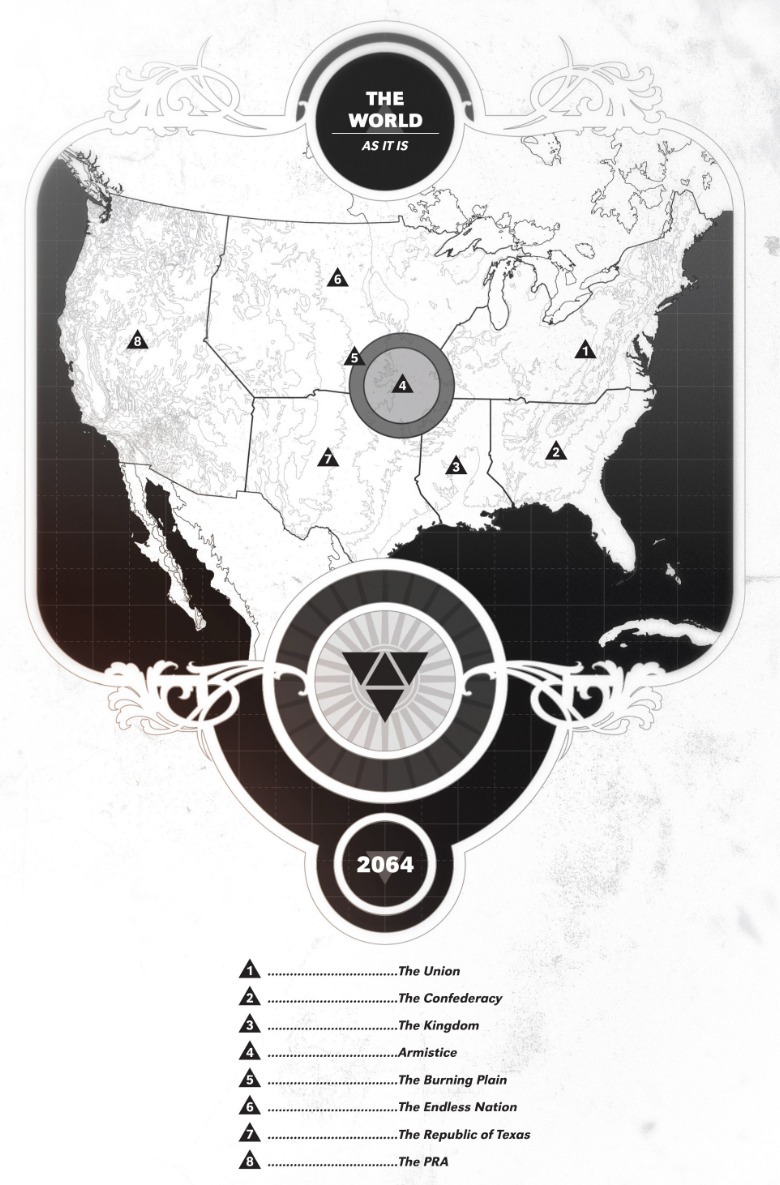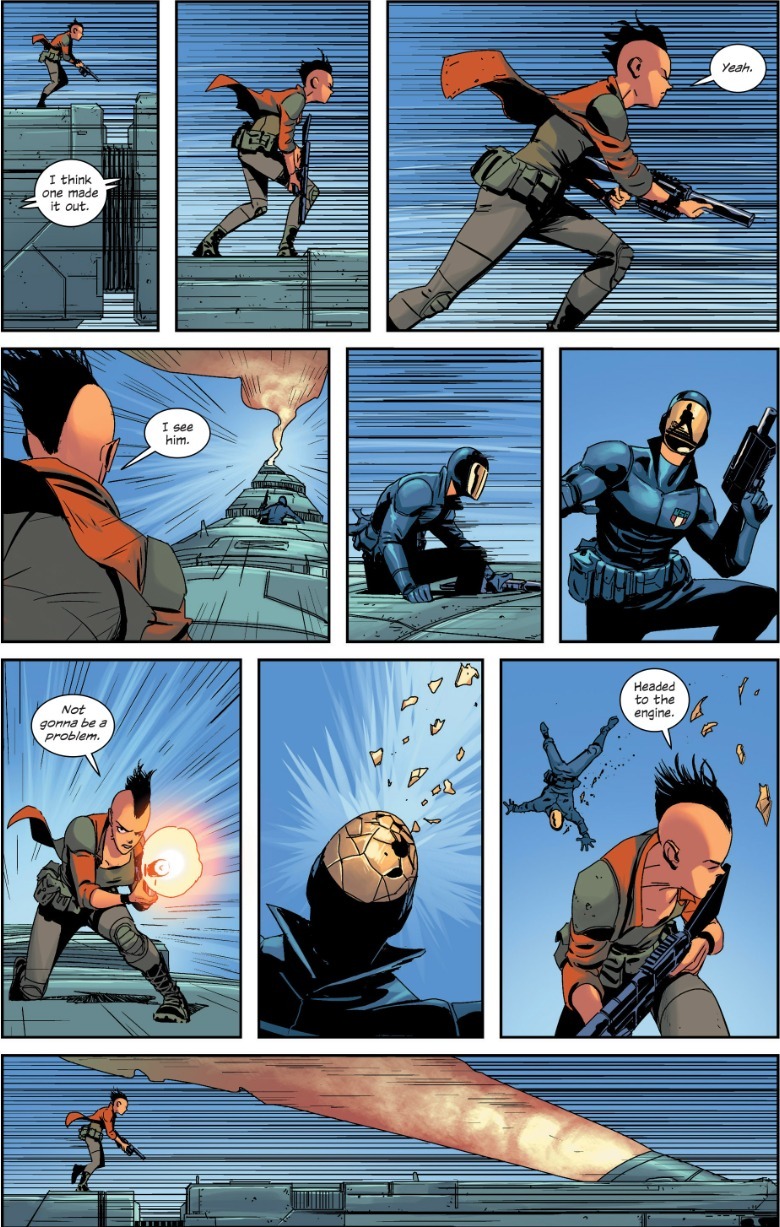The Sci-Fi Western Comic Book Series That Could Be The Next Game Of Thrones
We may receive a commission on purchases made from links.
Jonathan Hickman, writer of the beloved "Ultimate Spider-Man," and Nick Dragotta, pushing DC Comics to new heights by drawing "Absolute Batman," once worked together as a dream team on an Image Comic series: the densely-plotted and beautifully-drawn "East of West." The "East of West" #1 cover art shows a Western gunslinger holding a revolver pointed towards the reader, but don't expect a simple Western romp. "East of West" is a Western, but it brings in science-fiction and the supernatural. The story begins in 2064 A.D. of an alternate history where North America is divided into seven nations (plus an uninhabited "Burning Plain"):
Hickman and Dragotta said at New York Comic-Con 2013 that the former wanted to write a Western, and the latter wanted to draw science fiction. So, they compromised. Space Westerns are a mini-genre, but despite the advanced technology (including ships straight out of a space opera), "East of West" stays on Earth.
These seven nations inspire comparison to the Seven Kingdoms from "Game of Thrones." "East of West" similarly merges genre tropes, political squabbling, and supernatural prophecies. Archibald Chamberlain, a Confederate politician and one of the book's main villains, claims words and leverage are what shape the world, not action. He would know; he's a schemer who could outplay Littlefinger.
As streamers and networks look for the next "Game of Thrones," why hasn't "East of West" (which wrapped in 2019 at issue #45) crossed their radar? Prime Video announced an "East of West" television series in 2018, but Hickman confirmed in 2019 the project wasn't moving forward. Prime Video may hesitate at a second look when its "Fallout" show ticks similar boxes, but if you love Westerns, "Game of Thrones," or "Dune," you shouldn't hesitate to read "East of West."
East of West uses alternate history to explore a divided America
There's a reason Hickman and Dragotta set this story of tension between seven states in an alternate America. At NYCC 2013, Dragotta called the comic: "A reflection of our modern day culture more than anything, how divided we are."
"East of West" issues are interspersed with blank white pages with sentences alluding to the book's themes. The first one in issue #1 is "The things that divide us are stronger than the things that unite us." It's sometimes said that the American Civil War never really ended, and that's even more true in the alternate history of "East of West." In 1862, Confederate soldier Elijah Longstreet becomes a prophet. A year later, Native Chief Red Cloud unites tribes into an "Endless Nation." War rages until the signing of an armistice in 1908, when Longstreet and Red Chief both foresaw the eventual end of the world; 50 years later, Mao Zedong (founder of the People's Republic of America, PRA, instead of communist China) completed this "Message."
In the story's present day, a cabal of "the Chosen" — power players from all seven nations — work to bring about the Message's apocalyptic prophecies. The interweaving of religion and politics is where the "Dune" influence comes in. To borrow a phrase from "Game of Thrones," the words of the Message are not wind. That gunslinger from the issue #1 cover? He's literally Death himself, horseman of the apocalypse. He's albino and dressed in all white, à la Death's pale horse from the Book of Revelation.
While Death lives up to his name as a gunslinger, he's no longer interested in ending the world. He fell in love with a human, PRA Princess Xiaolian Mao, and his goal is rescuing their kidnapped son.
East of West mines hope from the apocalypse
The three other horsemen, War, Conquest, and Famine, still want the apocalypse, plus revenge on Death for killing their previous incarnations. They believe his son, Babylon, is the beast who will burn the world down. The suspense of the story is not just if Death can rescue Babylon, but if Babylon will be corrupted.
If Hickman's character building is strong, his worldbuilding is exemplary. Several of the seven nations amount to ethnostates, because the deepest divisions in America are racial. In "East of West," though, minorities have power they don't in the real world. The Endless Nation is the most advanced country, and while the Confederacy still exists, the antebellum status quo doesn't. African Americans founded a new nation, the Kingdom, in Louisiana, which used oil wealth to become a powerhouse. (Compare the real life Black Wall Street in Tulsa, Oklahoma, destroyed before it could rise.)
"East of West" is not all politics, though. A good Western needs some shoot-outs and Dragotta delivers. In "Absolute Batman," he uses small, unaligned panels to emphasize action beats, like a film using tightly-edited close-ups. He perfected this style in "East of West." Issue #31 features a mid-air hijacking, a la a Western train robbery, that plays to Dragotta's strengths.
Dragotta's action isn't his only strength; he draws character and creature designs as striking as a gunshot. Take the long-legged, flashlight-headed mounts the Horsemen use, or Famine's terrifying half-skull face. Yet despite the apocalyptic themes in this story, Hickman is an optimist: he ended his "Avengers" run by proclaiming "everything lives." "East of West" #45 similarly delivers a different "end of the world" than you'd expected. The characters' perilous ride to reach that ending makes it all the more satisfying.




